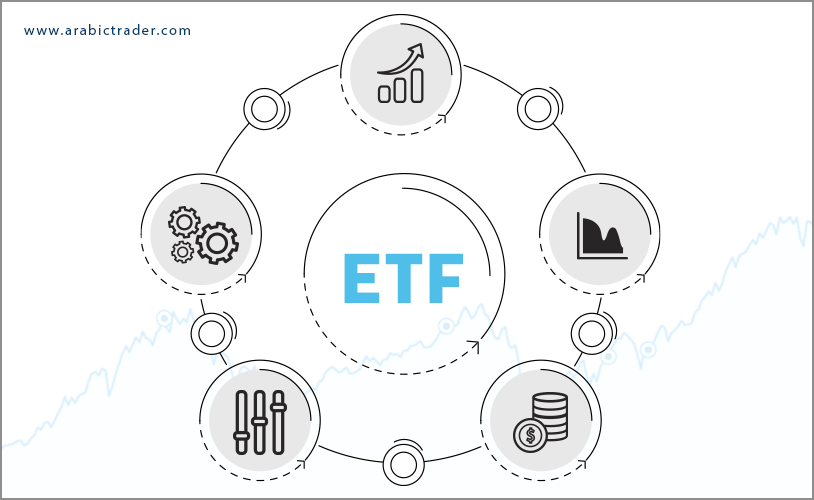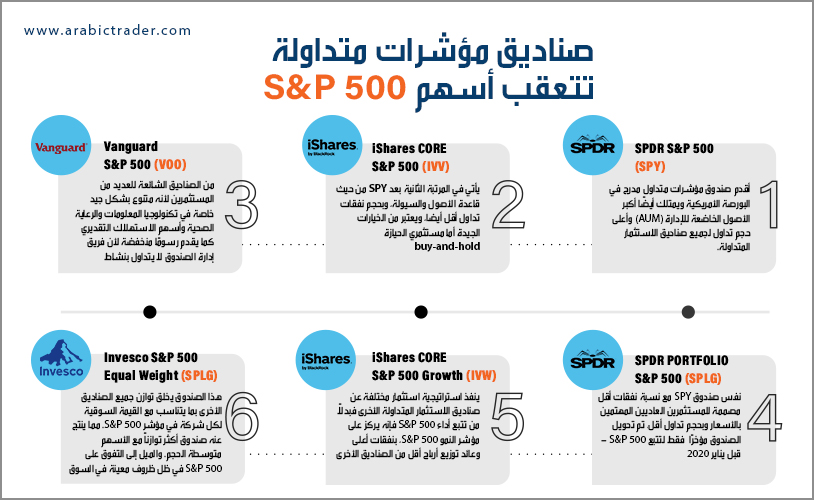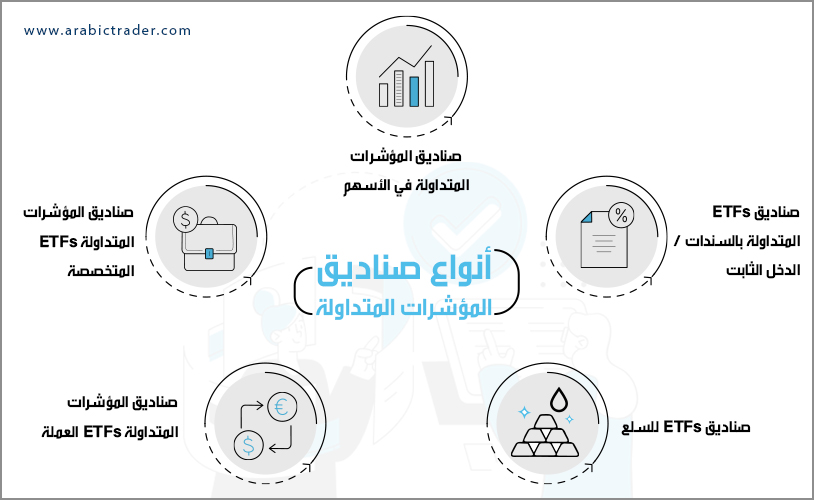Exchange Traded Funds - ETFs
Exchange-Traded Funds, or ETFs, are baskets of securities that you buy or sell through a brokerage on an exchange. They generally track a specific index, so when you decide to invest in them, you're investing in a collection of underlying assets. This provides a type of investment diversification and risk control, combining market flexibility with lower trading costs or commissions. In this article, we'll delve deeper into ETFs to understand what they are and how to benefit from them.
Our discussion covers the following key points:
What are Exchange-Traded Funds (ETFs)?
The simplest way to explain ETFs is by looking at their name:
- Exchange: This is where buying or selling occurs on exchanges, similar to stock transactions.
- Traded: ETFs have price fluctuations throughout the day or over a specific period due to market forces such as supply and demand, allowing for monitoring of the right price to execute trades.
- Fund: Like mutual funds, ETFs can contain a broad range of stocks or bonds within a single fund.

ETFs offer a flexible and relatively low-cost method of investing in a way that provides market flexibility and transparency. They track a specific index—such as the Hang Seng or S&P 500—and can be traded just like stocks. Some find them easier to trade than individual stocks, as they require less time and effort to select the right ETF compared to choosing individual stocks for investment.
ETFs also share similarities with mutual funds, which are investment products pooling money from various investors. Fund managers then invest this money in a mix of assets and securities to create diversification—unlike individual stock trading, aiming to achieve satisfactory returns. However, mutual fund shares cannot be bought or sold at any time.
Advantages and Disadvantages of ETFs
ETFs act as a bridge between the professionalism and diversification of mutual funds and the flexibility and ease of trading individual stocks. For most individual investors, ETFs are an ideal asset type for building a diversified portfolio.
-
Advantages:
- More diversified than investing in individual stocks. Investing in an ETF gives immediate exposure to many stocks in a single transaction.
- They reflect the performance of the tracked index, which makes their returns more predictable.
- Lower cost compared to fees for mutual funds. They may have higher trading costs than individual stocks but offer diversification.
- Higher trading flexibility, including the ability to enter or exit trades anytime during market hours. ETFs can be bought on margin and sold short, with live pricing throughout the day.
-
Disadvantages:
- ETFs, reflecting a variety of stocks, may not offer the same potential returns as individual stocks since diversification serves as a form of risk mitigation.
- Although they are low-cost, there are still management fees. If you're knowledgeable and experienced with stock market movements, managing your own investments might save you from these fees.
How ETFs Work
ETFs are traded on exchanges under specific ticker symbols, akin to dealing with a single financial asset. If an investor wants to invest in an ETF, they can purchase it directly through their stock trading platform, employing a passive investment strategy.
-
Passive Strategy: This long-term investment strategy aims to generate returns by purchasing securities that track or reflect stock market indices, reducing trading risk by investing in a mix of asset classes rather than individual stocks.
-
Active Investing: In contrast, active investing involves selecting individual stocks based on market analysis and movements to achieve returns through prediction and market analysis.

For example, if you wish to invest in all stocks in the Hang Seng Index, you buy an ETF contract tracking this index, which includes all 50 stocks in the same proportion as the index.
ETFs simply track stock indices like the S&P 500 and employ portfolio managers to invest their funds, charging management fees, usually a percentage of the invested amount. For instance, a 1% fee means paying $10 for every $1,000 invested, along with dividends. Most ETFs pay dividends, which can be taken in cash or reinvested automatically through a Dividend Reinvestment Plan (DRIP).
Types of ETFs
Today, there are approximately 8,000 ETFs globally, facilitated by technological advancements that simplify their creation, tracking, and trading. Types of ETFs include:

- Stock ETFs: Track stock indices and can focus on large or small companies, specific countries, industries, or sectors.
- Bond/Fixed Income ETFs: Offer fixed returns with lower risk compared to stock ETFs.
- Commodity ETFs: Cover commodities like gold, silver, or oil. These can diversify portfolios but are often less transparent as they may use derivatives rather than holding physical assets.
- Currency ETFs: Invest in a single currency or a basket of currencies, directly or through derivatives.
- Specialized ETFs: Include leveraged ETFs, which aim to amplify returns using leverage, and inverse ETFs, which profit when the target index falls.
Trading ETFs as Contracts for Difference (CFDs)
Trading CFDs allows investors to speculate on price movements of financial assets without owning the asset itself. Many licensed and reliable trading platforms offer ETFs trading through CFDs, using leverage and margin.
While ETFs are generally suited for long-term investments, many traders use CFDs for short-term speculation, seeking simplicity and quick profits without owning the underlying asset. Trading ETFs via CFDs combines flexibility and control for traders.
Conclusion
Exchange-Traded Funds (ETFs) offer a versatile and cost-effective investment option, combining the diversification benefits of mutual funds with the trading flexibility of individual stocks. By tracking specific indices, ETFs provide investors with exposure to a broad array of assets, which helps in managing risk and achieving portfolio diversification. They come in various types, including stock, bond, commodity, currency, and specialized ETFs, catering to different investment strategies and preferences.
ETFs are traded on exchanges, allowing for ease of access and liquidity, while their management fees are generally lower compared to mutual funds. However, they may not offer the same potential returns as individual stocks due to their diversified nature, and investors should be aware of ongoing management fees.
For those interested in short-term trading, ETFs can also be traded as Contracts for Difference (CFDs), providing additional flexibility and leverage. Whether you are a long-term investor or a short-term trader, understanding the characteristics and types of ETFs can help you make informed decisions and effectively integrate them into your investment strategy.
By leveraging ETFs, investors can build a balanced portfolio that aligns with their financial goals while benefiting from lower costs and increased trading flexibility.
An Exchange-Traded Fund (ETF) is a type of investment fund that trades on stock exchanges, similar to individual stocks. It holds a collection of assets, such as stocks, bonds, or commodities, and aims to track the performance of a specific index or sector. ETFs offer diversification by pooling various assets in a single fund and are traded throughout the day at market prices
ETFs work by tracking the performance of an index or sector. Investors buy shares of the ETF, which represent a proportional ownership of the underlying assets. The ETF’s price fluctuates throughout the trading day based on the value of its underlying assets. Unlike mutual funds, which are priced once a day, ETFs are traded on stock exchanges and can be bought or sold anytime during market hours.
ETFs provide several benefits, including:
- Diversification: By holding a range of assets, ETFs reduce the risk associated with investing in individual stocks or bonds.
- Cost-Effective: ETFs generally have lower management fees compared to mutual funds.
- Liquidity: ETFs are traded on exchanges, allowing investors to buy and sell shares throughout the trading day.
- Transparency: ETFs regularly disclose their holdings, allowing investors to see exactly what assets they own.
There are various types of ETFs, including:
- Stock ETFs: Track specific indices or sectors of the stock market.
- Bond ETFs: Invest in bonds and fixed-income securities.
- Commodity ETFs: Track the price of commodities like gold, silver, or oil.
- Currency ETFs: Focus on currencies or foreign exchange rates.
- Specialized ETFs: Include leveraged and inverse ETFs, which use financial derivatives to amplify returns or profit from market declines.
ETFs can be traded as Contracts for Difference (CFDs), allowing investors to speculate on price movements without owning the underlying assets. CFDs on ETFs provide the ability to trade with leverage, meaning you can control a larger position with a smaller amount of capital. However, trading ETFs as CFDs involves higher risk and requires careful monitoring of market conditions and leverage levels.

.png)
